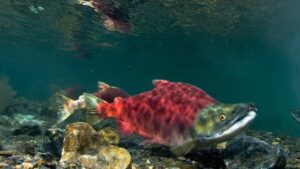
Preliminary data compiled by the Alaska Department of Fish and Game show that the run of sockeye salmon run to Bristol Bay in 2023 was 54.5 million fish, with runs to every district within this easternmost arm of the Bering Sea exceeding preseason forecasts.
Data show that the run itself was the eighth largest inshore run since 2003 and 17% above the 46.7 million average run for the latest 20-year period, stretching from 2003 to 2022.
All sockeye salmon escapement goals were met or exceeded, with a total bay-wide escapement of 13.9 million fish, according to the preliminary document issued on Sept. 22.
The ex-vessel value of salmon harvested in Bristol Bay in 2023, calculated by using the fish ticket weight and price paid for each species, totaled $117.4 million for all salmon species caught in the bay, which was 37% below the 20-year average of $187.6 million.
ADF&G officials noted that prices are based on the major buyers’ base price and don’t include price adjustments for icing, bleeding, floating or production bonuses.
The 2023 harvest of 40.6 million sockeyes was 21% higher than the recent 20-year average of 31.9 million for all districts. The red salmon escapement goal was exceeded in the Igushik River, but all other systems were within their respective escapement goal ranges.
The 2013 run of sockeyes to Bristol Bay was dominated by “three-ocean” fish, or fish with three years of ocean growth. The average weight of these sockeyes was 5.5 pounds, slightly larger than in recent years, due to the high percentage of three-ocean fish.
Chinook salmon harvested in Bristol Bay were incidentally caught during the directed Sockeye salmon fishing periods. The Nushagak District, the main contributor of Chinooks, was again actively managed to reduce Chinook harvest in an effort to meet the escapement goal.
Overall, the 2023 Chinook harvests were below average in all districts, including the Nushagak District with a harvest of 6,847 fish, well below the 20-year average of 32,491 fish.
The preliminary chum harvest of 342,905 was well below the recent 20-year average of 1.1 million fish.
There was no directed fishery for pink salmon because they are predominantly an even year species in Bristol Bay and not in abundance.
The preliminary coho salmon harvest of 15561 fish was also below the 20-year average of 97,620 fish.
